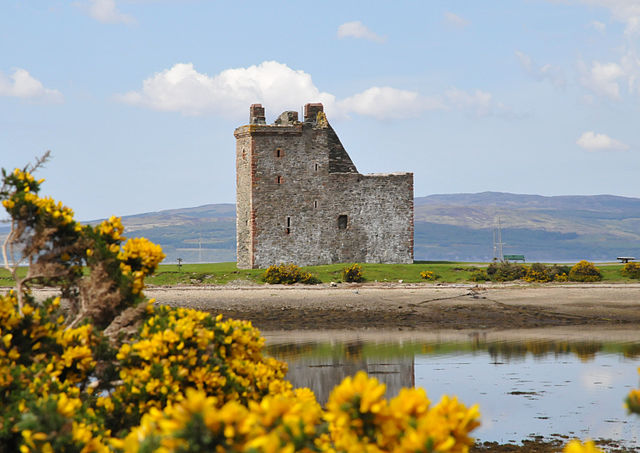Murchadh Mac Suibhne was a leading member of Clann Suibhne. He was a grandson of the family's eponymous ancestor Suibhne mac Duinn Shléibhe, and a nephew of the family's mid-thirteenth-century representative, Dubhghall mac Suibhne.
Now-ruinous Skipness Castle may have been constructed by Murchadh's uncle, Dubhghall mac Suibhne. The fortress is first attested in 1261 by a charter that describes Dubhghall as the castle's lord. Murchadh is listed as one of the charter witnesses.
The effigy of Walter Stewart, Earl of Menteith and his wife, Mary I, Countess of Menteith. It is the earliest effigy of a married couple, side by side on the same tomb, in the British Isles.
The coat of arms of Hákon Hákonarson as depicted on folio 150r of British Library Royal 14 C VII (Historia Anglorum).
The view from the ruins of Skipness Castle in Kintyre, across the Kilbrannan Sound, towards Arran. In 1263, Hákon granted Murchadh the island for his service to the Norwegian Crown. The castle across the sound from Skipness, Lochranza Castle, may have been built by Dubhghall.
Dubhghall mac Suibhne was a Scottish landholder in Argyll, and a leading member of Clann Suibhne. He was a son of Suibhne mac Duinn Shléibhe, and appears to have held lordship of Knapdale from at least the 1240s to the 1260s, and may have initiated the construction of Skipness Castle and Lochranza Castle.
Now-ruinous Skipness Castle may have been constructed by Dubhghall. From this site, the castle's occupants would have had a clear view across the Kilbrannan Sound to Arran. The castle is first attested in 1261 by a charter which describes Dubhghall as its lord.
Now-ruinous Lochranza Castle may have been built by Dubhghall. The visible tower house is what remains of a late mediaeval redevelopment of a thirteenth-century hall house.
Ruinous Castle Sween, one of Scotland's oldest standing stone castles, seems to have been built by Dubhghall's father, eponym of both Clann Suibhne and the castle itself.
Coat of arms of Alexander II as it appears on folio 146v of British Library Royal 14 C VII (Historia Anglorum). The inverted shield represents the king's death in 1249.








